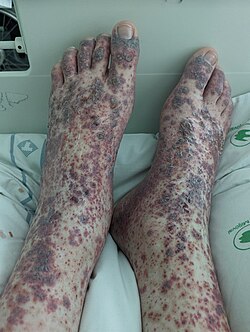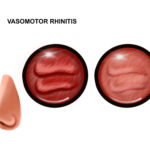Vasculitis refers to a group of rare disorders characterized by inflammation of blood vessels, including arteries, veins, and capillaries. This inflammation leads to changes in vessel walls—thickening, weakening, narrowing, or scarring—which can restrict blood flow and damage vital tissues and organs. The severity of vasculitis ranges from mild and self-limiting to life-threatening, depending on the organs involved and the rapidity of onset.

Causes and Risk Factors of Vasculitis
Primary Causes
- Autoimmune Reactions: The immune system mistakenly attacks healthy blood vessels.
- Infections: Hepatitis B, hepatitis C, HIV, and other viral infections can trigger secondary vasculitis.
- Medications: Certain drugs such as hydralazine, allopurinol, and minocycline have been linked to vasculitis.
- Cancers: Hematologic malignancies like lymphoma can initiate paraneoplastic vasculitis.
- Genetic Factors: Some forms, such as Behçet’s disease, have a hereditary component.
Risk Factors
- Age (specific types affect certain age groups)
- Autoimmune disorders (e.g., lupus, rheumatoid arthritis)
- Chronic infections
- Smoking
- Exposure to toxins
Common Types of Vasculitis
Large Vessel Vasculitis
- Giant Cell Arteritis (Temporal Arteritis)
Affects arteries in the head, especially the temporal arteries; common in adults over 50. - Takayasu Arteritis
Affects the aorta and its branches; predominantly in young women.
Medium Vessel Vasculitis
- Polyarteritis Nodosa (PAN)
Involves medium-sized arteries, leading to organ ischemia; often linked to hepatitis B. - Kawasaki Disease
Pediatric disease causing inflammation of coronary arteries; may lead to aneurysms.
Small Vessel Vasculitis
- Granulomatosis with Polyangiitis (GPA)
Formerly Wegener’s granulomatosis; affects lungs, kidneys, sinuses. - Microscopic Polyangiitis (MPA)
Involves capillaries, venules, arterioles; causes renal and pulmonary issues. - Eosinophilic Granulomatosis with Polyangiitis (EGPA)
Formerly Churg-Strauss syndrome; marked by asthma and eosinophilia. - IgA Vasculitis (Henoch-Schönlein Purpura)
Mostly seen in children; causes purpura, arthritis, and kidney issues. - Cryoglobulinemic Vasculitis
Often linked to hepatitis C; involves skin, kidneys, nerves.
Symptoms of Vasculitis
Vasculitis symptoms vary by type and severity but commonly include:
General Symptoms
- Fever
- Fatigue
- Weight loss
- Night sweats
- Muscle and joint pain
Organ-Specific Symptoms
- Skin: Rashes, ulcers, purpura
- Lungs: Cough, shortness of breath, hemoptysis
- Kidneys: Hematuria, proteinuria, hypertension
- Nervous System: Numbness, weakness, stroke-like symptoms
- Eyes: Vision changes, redness, pain
- Gastrointestinal Tract: Abdominal pain, bleeding, nausea
Diagnostic Approach for Vasculitis
Timely diagnosis is essential to prevent irreversible damage.
Laboratory Tests
- Erythrocyte Sedimentation Rate (ESR)
- C-Reactive Protein (CRP)
- Complete Blood Count (CBC)
- Antineutrophil Cytoplasmic Antibodies (ANCA): Useful in GPA and MPA
- Anti-Glomerular Basement Membrane (anti-GBM): In renal vasculitis
- Complement Levels: Often low in cryoglobulinemic vasculitis
Imaging
- CT and MRI Scans: Identify affected organs and vascular abnormalities.
- Angiography: Reveals vessel irregularities, aneurysms, or stenosis.
- Ultrasound: Used in temporal arteritis diagnosis.
Biopsy
The gold standard for confirmation, especially in skin, kidney, nerve, or temporal artery involvement.
Treatment of Vasculitis
The treatment strategy depends on the type, severity, and affected organs.
Initial Therapy (Induction Phase)
- Corticosteroids (e.g., Prednisone)
Mainstay therapy to suppress inflammation. - Immunosuppressants
Cyclophosphamide or rituximab is used in severe cases, especially ANCA-associated vasculitis.
Maintenance Therapy
- Azathioprine, Methotrexate, or Mycophenolate Mofetil
Used to maintain remission after initial disease control.
Biologic Agents
- Rituximab: For refractory ANCA vasculitis.
- Tocilizumab: Approved for giant cell arteritis.
- IVIG: In Kawasaki disease or severe cases unresponsive to steroids.
Supportive Treatments
- Blood pressure control
- Antiviral therapy (if hepatitis-related)
- Osteoporosis prevention in long-term steroid use
- Prophylactic antibiotics (e.g., Pneumocystis pneumonia prevention)
Complications of Vasculitis
- Renal failure
- Vision loss
- Peripheral neuropathy
- Gastrointestinal perforation
- Pulmonary hemorrhage
- Stroke or myocardial infarction
Early recognition and treatment are crucial to minimizing these risks.
Prognosis and Long-Term Outlook
The prognosis depends on the specific type, organ involvement, and response to treatment.
- Good Prognosis: In limited, skin-only vasculitis or well-managed ANCA vasculitis.
- Guarded Prognosis: In rapidly progressive glomerulonephritis or severe pulmonary hemorrhage.
Regular follow-up with rheumatology, nephrology, or pulmonology is vital in preventing relapses and complications.
Preventive Strategies and Lifestyle Recommendations
Although vasculitis cannot always be prevented, we can reduce the risk of flare-ups and damage through:
- Timely vaccination (e.g., influenza, pneumococcal)
- Smoking cessation
- Monitoring and managing chronic conditions
- Adhering strictly to prescribed medications
- Minimizing stress and infection exposure
- Nutritional support and adequate hydration
Support Resources for Patients and Families
Effective management of vasculitis extends beyond medications.
Patient Support
- Vasculitis Foundation
- Rare Disease support networks
- Local or online peer groups
Caregiver Guidance
- Education on disease management
- Emergency action plans
- Mental health support
Vasculitis encompasses a diverse group of serious inflammatory diseases affecting blood vessels, with potential for significant organ damage if left untreated. Through early diagnosis, individualized treatment plans, and consistent follow-up, patients can achieve sustained remission and improved quality of life. Continued advancements in biologic therapies and precision diagnostics are transforming outcomes in even the most severe cases.

